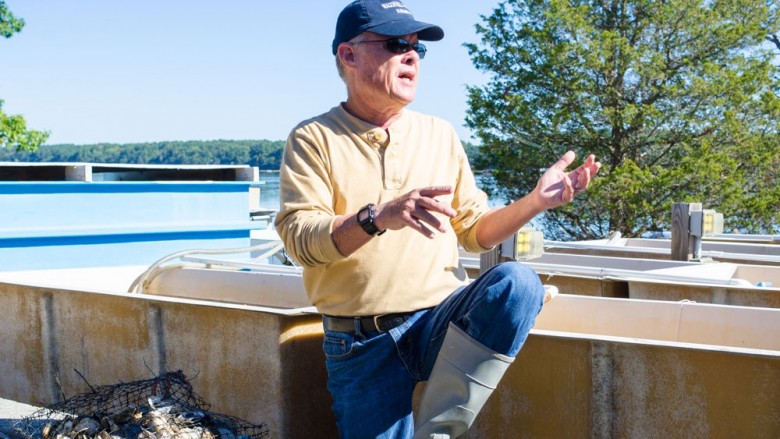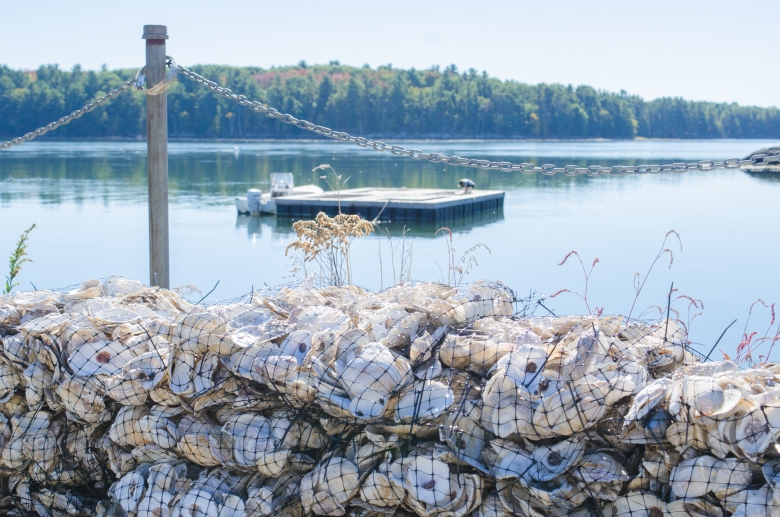Great Bay oyster reef reboot aided by local restaurants
By Beth Treffeisen | October 20, 2015, 12:49 EDT
 Dr. Ray Grizzle a UNH research biologist explains how he uses recycled oyster shells. (Beth Treffeisen)
Dr. Ray Grizzle a UNH research biologist explains how he uses recycled oyster shells. (Beth Treffeisen) It’s been 10 summers since Robert’s Maine Grill began serving New England seafood classics updated with ingredients sourced from local farms and fishing vessels. So when owner Michael Landgarten was asked to become a partner with the University of New Hampshire’s oyster seeding program, he couldn’t say no.
The initiative uses cleaned shells to grow newly hatched oysters, which draw needed nutrients from the old shells. The mollusks provide a natural filtration system for the bay, removing tiny organisms and creating an environment conducive to the growth of eel grass, which shelters an array of fish and other creatures that nourish other fish, seabirds and waterfowl.
“They are beautiful shells and to just put them in the trash is just weird,” Landgarten said. Despite the extra sorting work for the kitchen help in his nearby Kittery, Maine, restaurant, he is happy to collaborate on the project to replenish shellfish in the estuary, which is fed by several sources, including the Squamscott, Lamprey and Oyster rivers in New Hampshire. The bay empties into the Gulf of Maine through the Piscataqua River that separates Maine from New Hampshire.
The seeding program aims to restore an oyster population that by the early 1990’s had been almost wiped out in Great Bay. About 90 percent of the estuary’s oyster beds had been lost to disease, overfishing, pollution and silting, according to UNH reports. In particular, two parasitic diseases: MSX and Dermo had killed off most of the shellfish. Ultimately the bay’s oyster-sheltering reefs shrank from 1,100 acres under to almost none.
-
Now, working with the Coastal Conservation Association of New Hampshire (CCA), UNH ’s Jackson Estuarine Lab, Landgarten’s grill and other participating restaurants, reef rebuilding with leftover shells has created about 20 acres of new oyster reefs. The effort has collected close to 6,000 bushels of shells from restaurants. But more are needed.
“The project really needs to scale up. We have one trailer and a bunch of little old guys,” said Phil Philbrick, a CCA representative. He said that six volunteers use the trailer to collect shells from the participating restaurants. Still, he said those efforts have produced results. “If everybody does it a little bit, it adds up a lot.”
Volunteers help bag the leftover shells and bring them to the UNH Kingman Farm in Madbury, where they’re left to dry in the sun after they’ve been cleaned.
Once the shells are ready, Ray Grizzle, a UNH research biologist, and the Nature Conservancy take over, directing the placement of some shells in permitted areas of the estuary that are off limits to fishing. The shells are added to existing reefs to enlarge them and provide additional habitat for oysters.
Some shells are also given to dozens of volunteers who live around the bay and who help the project by providing small nurseries for the larval oysters, called spat. The larva attach themselves to the cleaned shells as a source of calcium carbonate they need to grow. Once the baby oysters grow large enough to survive, they’re placed on the newly created reefs.
Oysters in the bay generally must be harvested by their third or fourth year or they will die from MSX or Dermo infestation, Grizzle said. Up until that age, the parasites don’t do anything to the physiology of oysters. Neither parasite has any effect on people.
Grizzle is also an oyster farmer, which can involve growing them in retrievable arrays called condos. Local oyster farmers provide the shellfish to Landgarten’s restaurant and Taylor Lobster Co. in Kittery is also a supplier.
When served up to diners, two things determine the flavor of the oysters : the environment in which they’ve grown and their physiology. Taylor Lobster’s Tom Robinson said the best time to eat the shellfish arrives in fall and winter, when they are plump after getting ready to hibernate over the colder months.
“‘When you eat an oyster,’ I always tell my friends, ‘don’t put anything on it yet. Eat the first oyster naked,’” Robinson said.
Helping to seed oysters with shells to restore the local population lets restaurants participate in creating the habitat that’s needed to produce a food they plan on serving for years to come. It helps to provide a sustainable source of shellfish and keeps oyster lovers coming back.
“It’s free,” Landgarten, the Robert’s Maine Grill owner, said about participating in the program. “It’s a win-win for us.”
Contact Beth Treffeisen at [email protected]












